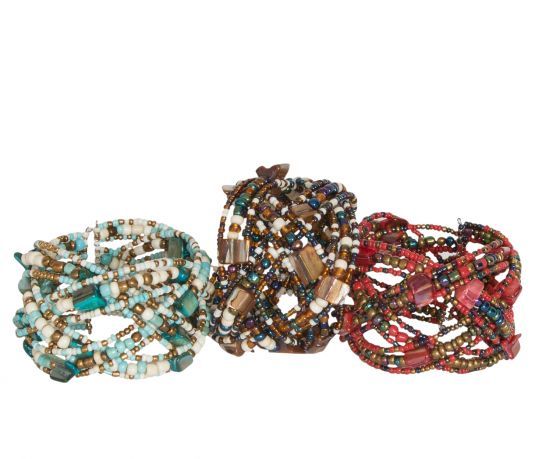We use cookies to make your experience better.
Indian braid bracelet from New Mexico in the U.S.A. Beautiful handmade bracelets with gemstone.
The Dineh (Dinéh, Diné) or Navajo are a people of North American Indians, the majority of whom live in Dinetah (Dinétah), the Four Corners Reserve in the desert states of the United States. In the 2005 census, 338,443 Dineh were registered in the United States. The name given to the Dineh according to some sources of the Spaniards and according to other sources of the Pueblo peoples (Navajo would be derived from a word that means "thief of the country"), is Navajo. This name is still used by many people today, although the people themselves prefer the name Dineh. The pronunciation is na-WA-cho, the Anglo-American corruption of it is NA-va-ho. The Dineh descend along with the N'de (Apache) from Athapaskan peoples who spoke the Na-Dené language, and still live in central Canada. The name Dineh is very similar to the name that the related Chipewyan from Canada gave themselves: Denesuline. The ancestors of the Dineh and N'de migrated in great numbers to the deep south around 1500 and began to develop nomadic life in the desert and prairie areas of Arizona, Utah and Colorado. Originally the Dineh and N'de formed one people, but for unknown reasons the group split up. When the Dineh had for years been feeding themselves on the plains for food by sheep, bison and farming, the N'de still lived in the mountains of the San Francisco mountains. Due to the dry climate in the desert areas, agriculture has never developed into the most important form of existence for the Dineh. Most of the food came from the bison, which existed over central North America, and the large flocks of sheep managed by the Dineh. Both men and women worked as shepherds, but the few crops that were cultivated had to be cared for and harvested by the women. The scarcity of water in the region made a nomadic existence necessary. In order to obtain additional facilities, the surrounding villages of the Tewa and Hopi peoples were pillaged with such regularity at harvest time that the routes of the Dineh in the country were worn out as paths. Like the N'de, but unlike the Pueblo, the Dineh did not make houses out of clay, but lived in hogan. These had the advantage that they were quickly packed and easily transported. Normally the hogans were set up in canyons or under steep cliffs, where they were difficult to see by enemy scouts on top of the hills. The daily administration was led by a tribal elder who asked for advice from other elders and the warriors. These could decide together to go to war or to make peace; the greatest opponents of the Dineh were the Pueblo, with whom there was much struggle over the rule over the land and the right to hunt the bison herds. The Dineh knew a religion that was deeply rooted in and almost exclusively consisted of the belief in the healing effect of songs, which were often sung by a medicine man. One did not pray to a god or spirit, but sang a certain song to cure a specific illness; the subjects of the songs often had a mythical or prayerful background. There were chants about the mountains, the bison, the water and almost everything else that was important in the life of the Dineh. In a song it is sung how a particular aspect of the world originated. Important verses are sometimes repeated up to four times to enhance their effect. Nowadays we know that there have been at least thirty-five healing songs, which together contain more than five hundred songs that the medicine man had to learn by heart. In addition to the songs, the Dineh also made sand paintings based on the themes from their songs. Such a painting was made with paint in the sand and was large enough for the sick person to sit or kneel. Within a circle, the animal or object was then drawn about which the song told and from which the patient had to withdraw the healing powers by means of the song of the medicine man. Each of the thirty-five songs had its own painting.












